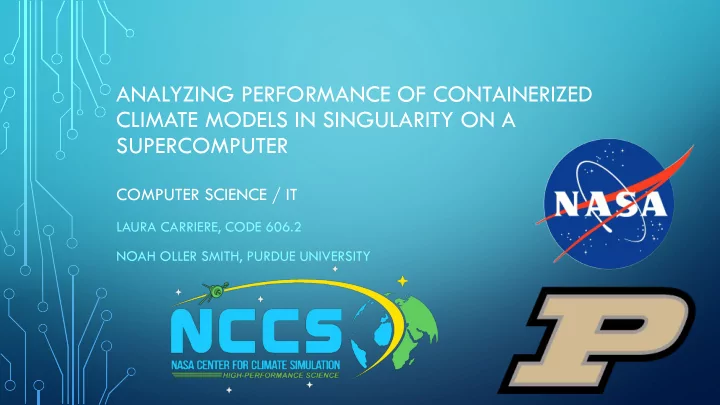

ANALYZING PERFORMANCE OF CONTAINERIZED CLIMATE MODELS IN SINGULARITY ON A SUPERCOMPUTER COMPUTER SCIENCE / IT LAURA CARRIERE, CODE 606.2 NOAH OLLER SMITH, PURDUE UNIVERSITY
INTRODUCTION AND BACKGROUND • Software is currently deployed in HPC via modules and package managers • Containers provide easy software deployment and different environments • Singularity vs Docker - Singularity is made for HPC and can make use of docker resources. This is Discover, a supercomputing cluster with over 129,000 cores for NCCS!
QUESTION / INVESTIGATION • Testing to see whether a containerized version of a part of GEOS (Goddard Earth Observing System) can compete with a non-containerized version • Mainly looking at performance impact on containerized versions • GEOSgcm and GEOSfvdycore were containerized • GEOSfvdycore was containerized for testing
METHODS AND APPROACH • Had to learn usage of Singularity & Slurm – Used Docker and PBS before NASA • Created multiple containers for testing, including Debian 10, Fedora 33, and CentOS 7 • Before containerizing GEOSfvdycore, the base libraries had to be containerized first
METHODS AND APPROACH • Two parts to a run: Actually setting up the experiment and then running. • Wanted to see longer and shorter compute times. • Horizontal resolution of experiments was changed to get a better idea of efficiency • Each container and the non-containerized version got 3 runs on a single node for longer and shorter compute times
RESULTS AND GRAPHS OS Type vs. Average Time for Longer OS Type vs. Average Time for Shorter Computations Computations 90 12 80 82.7 10 70 71 AVERAGE TIME (MINUTES) AVERAGE TIME (MINUTES) 70 60 8 64 50 6 40 10.5 9.1 8.2 8.2 30 4 20 2 10 0 0 Fedora 33 No Container Debian 10 CentOS 7 Fedora 33 No Container Debian 10 CentOS 7 OS TYPE OS TYPE
DISCUSSIONS AND CONCLUSIONS • Tests definitely indicate that containers can compete with non-containerized versions • Containers could have done well from having up-to-date software libraries that GEOSfvdycore depends upon compared to Discover • Topics to move forward on this project would include minimizing the container size and improving how models can be executed
REFERENCES AND ACKNOWLEDGEMENTS • Singularity documentation https://sylabs.io/docs/ • Slurm documentation https://slurm.schedmd.com/documentation.html • MPI Tutorial https://mpitutorial.com/ • GEOS-5 wiki https://geos5.org/wiki/index.php?title=GEOS- 5_Earth_System_Modeling_and_Data_Assimilation • Special thanks to Laura Carriere, Matt Thompson, Kenneth Peck, Jordan Caraballo-Vega, and Bruce Pfaff
Recommend
More recommend